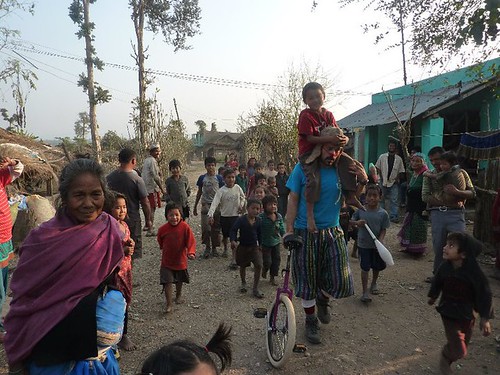As children, many of us dream of being in the circus. That dream, however, can quickly become a nightmare. Many child circus performers in the third world are trafficked, abused and neglected. They aren’t willing participants in the circus show, but rather forced by unscrupulous circus owners in search of a fast buck.
Luckily, people are working to put a stop to this disturbing practice. The Esther Benjamins Trust is an organization devoted to rescuing exploited Nepalese child performers. The group works with local law enforcement to shut down circuses using illegal child labor. They also provide traditional schooling and professional circus training to the rescued performers, helping them develop the skills necessary to support themselves as they grow older.
Joaquín López, a Mexican-born clown and juggler, learned his craft the hard way. After making a living performing on the streets of Mexico City, Joaquín began travelling throughout Latin American, eventually settling in New York City. Although he enjoyed life in New York, Joaquín knew he had a higher calling. He soon left the cosmopolitan comfort of the big city to work with the child circus refugees of Nepal. Joaquín was kind enough to spend some time with us talking about his experiences.
Tell us about the children you’re working with. How did they get to your organization?
Some of the children that I worked with were victims of human trafficking. “Agents” convinced them to travel to India to get jobs in Indian circuses but most of the times they lived in very bad conditions. In some cases the families ask the organization for help to rescue this kids. After we rescue them, if the family doesn’t have the resources to take care of them, the organization provides a place to live, schooling, food and sometimes even a job. Others kids are street kids or victims of violence, even some of them were in prison in Nepal.
What is life like for the average child circus performer in South Asia?
I don’t have the answer to this question. What I do know is that in some Indian circuses they use child labor and not in a creative or artistic way. They teach the kids the skills in a mechanic way repetition and repetition, like robots. That is the reason that Esther Benjamins Trust created a circus company named “Sapana” to try to give the kids a new opportunity with the circus but this time in an artistic and creative way.
How is Nepal? Is it very different from the other places you’ve lived (Mexico City, NYC, Guatemala, Honduras, etc)
Is really different from other parts of the world that I’ve lived. The first difference and the biggest for me was the religion because it is everywhere in public life. The principal religion there is Hinduism and the second is Buddhism; many cultural traditions are mixed with these two religions. The most wonderful thing is that people practice both religions in peace.
What do you hope to achieve with these young people?
I hope that this new experience with the circus helps them in two different ways: help them to get a job so they become self sufficient and in the other hand, to take the negative experiences these children had in the circus and turn them into positive ones.
How do you think this experience has changed you as a performer and as a teacher?
Well, as a performer always is good to try different audiences. Some things that work for you with some people don’t work with others. So the experience was excellent to practice my improvisational skills.Because the people there speak Nepali I am required to communicate by unconventional methods. As a teacher, usually I am a social circus instructor so, the visit was perfect to increase my experience, to realize again that social circus is about more sharing and learning than teaching. Also the experience with these kids was awesome because they are very good kids with a very big heart. This was my big learning experience there, how to have the big heart that they have.
Click below to see a mini documentary on the Esther Benjamins Trust, including stunning images of a rescue operation and touching footage of rescued performers in action:
Telapayaso report. Nopal in Nepal from Kolectivo Que Da Alegría on Vimeo.








